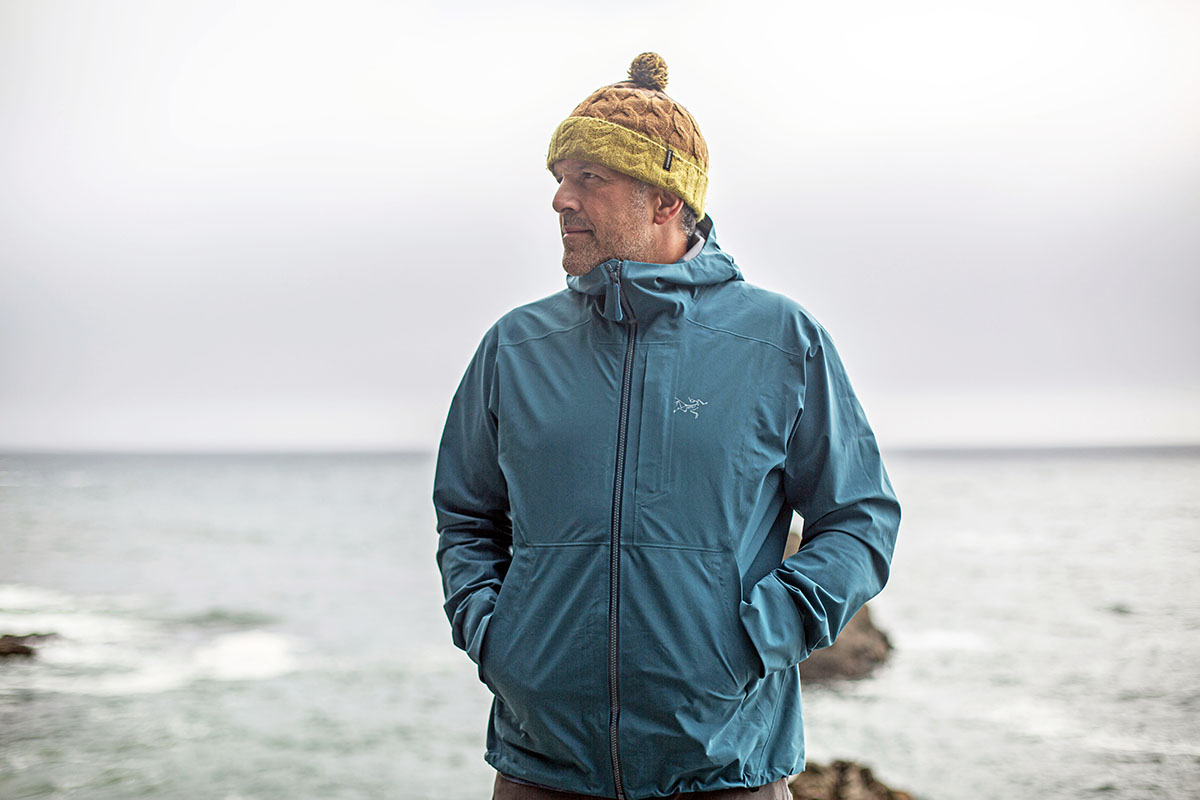
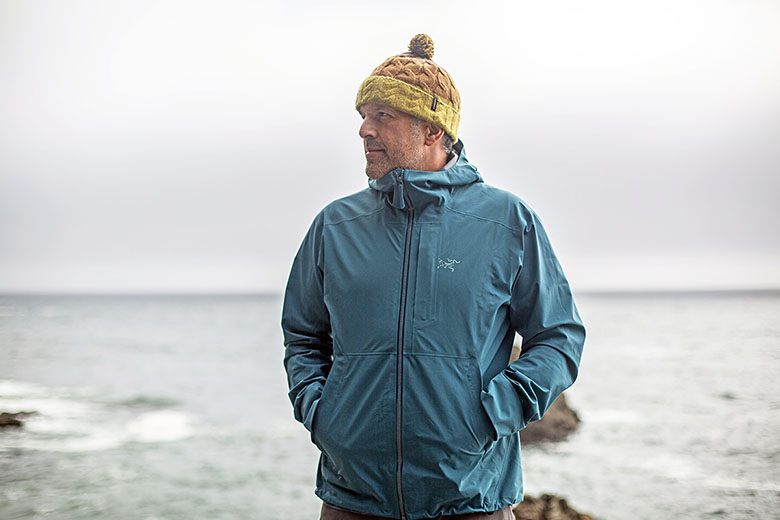
Price: $500
Weight: 15.8 oz. (men’s large)
Waterproofing: 3L Gore-Tex with C-Knit
What we like: Top-notch protection, durability, and comfort in an everyday-friendly package.
What we don’t: Very pricey for a casual design; overbuilt for most urban settings.
See the Arc'teryx Ralle Jacket
Arc’teryx is a longstanding leader in the technical hardshell market, and much of that expertise trickles down to their more casual offerings. Their Ralle Jacket is case in point: This everyday rain shell offers top-notch protection with proven 3-layer Gore-Tex waterproofing and a nice assortment of weather-ready features, and Arc’teryx didn’t skimp on comfort or durability, either. It’s very pricey for a casual design at $500 and overbuilt for most urban settings, but for mixed outdoor and around-town use in areas with variable weather (like the Pacific Northwest), it’s a really premium and versatile design that looks great to boot. Below we outline our experiences with the Ralle Jacket. To see how it stacks up to the competition, see our article on the best hardshell jackets.
With a 3-layer Gore-Tex build, thick fabrics, and a durable water repellent (DWR) coating, the Arc’teryx Ralle Jacket has been a stalwart companion during a particularly wet and windy spring on Vancouver Island. As expected from a Gore-Tex shell, the Ralle has a very trustworthy feel and has deftly shrugged off everything from cold ocean winds to sideways rain while camping shoreside on the Juan de Fuca Trail. The shell also impressed me on a multi-day canoe trip, where it put up a solid defense against all-day drizzle and howling winds. All told, it’s another confidence-inspiring design from the brand that I fully trust to keep me dry and protected in wet and blustery conditions.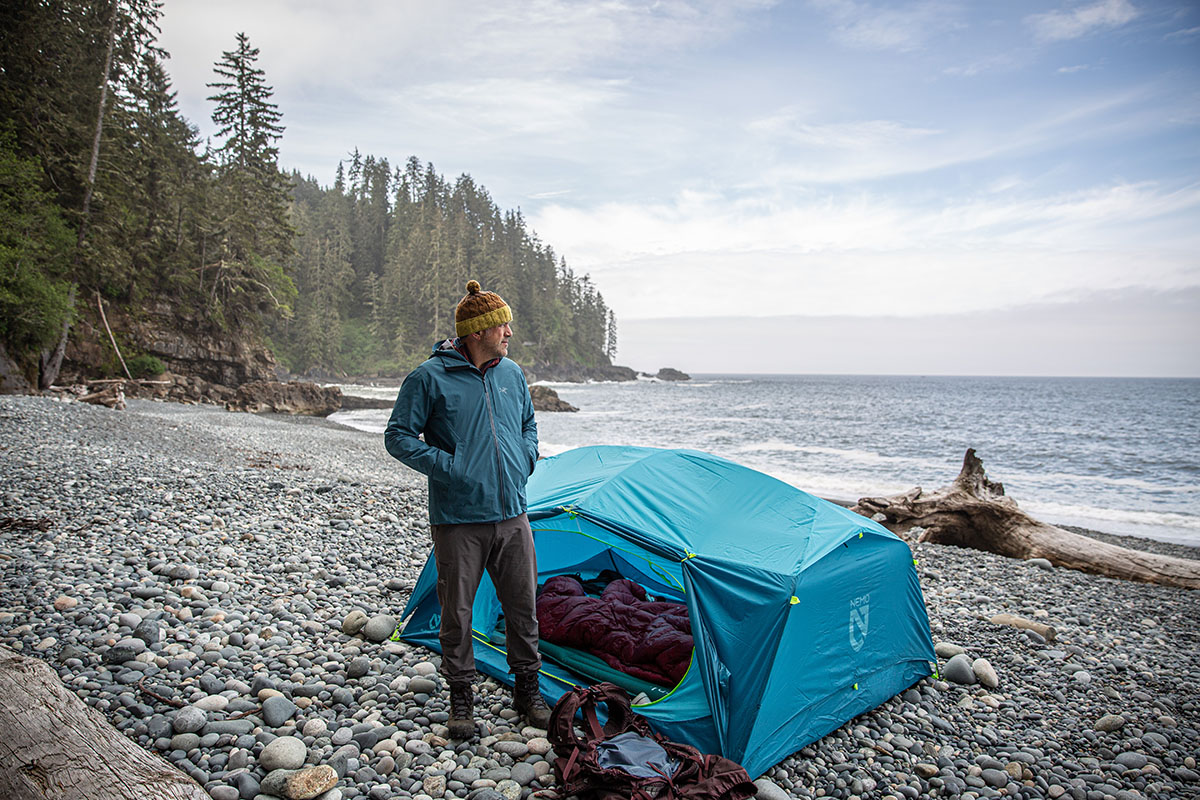
In addition to its reliable materials, the Ralle also comes well equipped for sealing out the elements with a nice assortment of protective features. For starters, the StormHood is easily adjustable, stays in place even in strong winds, and leaves only my nose and eyes exposed when cinched tight (the tall collar certainly helps). You also get a hem drawcord and internal elasticized cuffs that are protected by the outer Gore-Tex fabric, have a snug but comfortable fit, and effectively keep moisture out. Even while padding and fishing, I’ve had no issues with water making its way to my skin or baselayer. Finally, the exterior pockets are all protected by flaps and feature “garages” to seal out moisture when zipped shut. This adds a little weight and bulk compared to Arc’teryx’s sleek WaterTight zippers found on many of their more technical offerings, but I haven’t had any issues with protection.
I run decidedly warm and often can’t wear a Gore-Tex shell while exerting, and the Ralle was no exception. While the 3-layer design is decently breathable, there are no pit zips to quickly dump excess heat. Opening the main zipper will certainly help with airflow, but that’s not always possible in inclement weather. In my experience, the Ralle is best suited for more casual outings like hanging around camp, walking around town, fly fishing, or canoeing when you're unlikely to work up a sweat. For more technical and involved pursuits like hiking, backpacking, or climbing, I’d opt for a more breathable and pit zip-equipped design like Arc’teryx’s own Beta LT.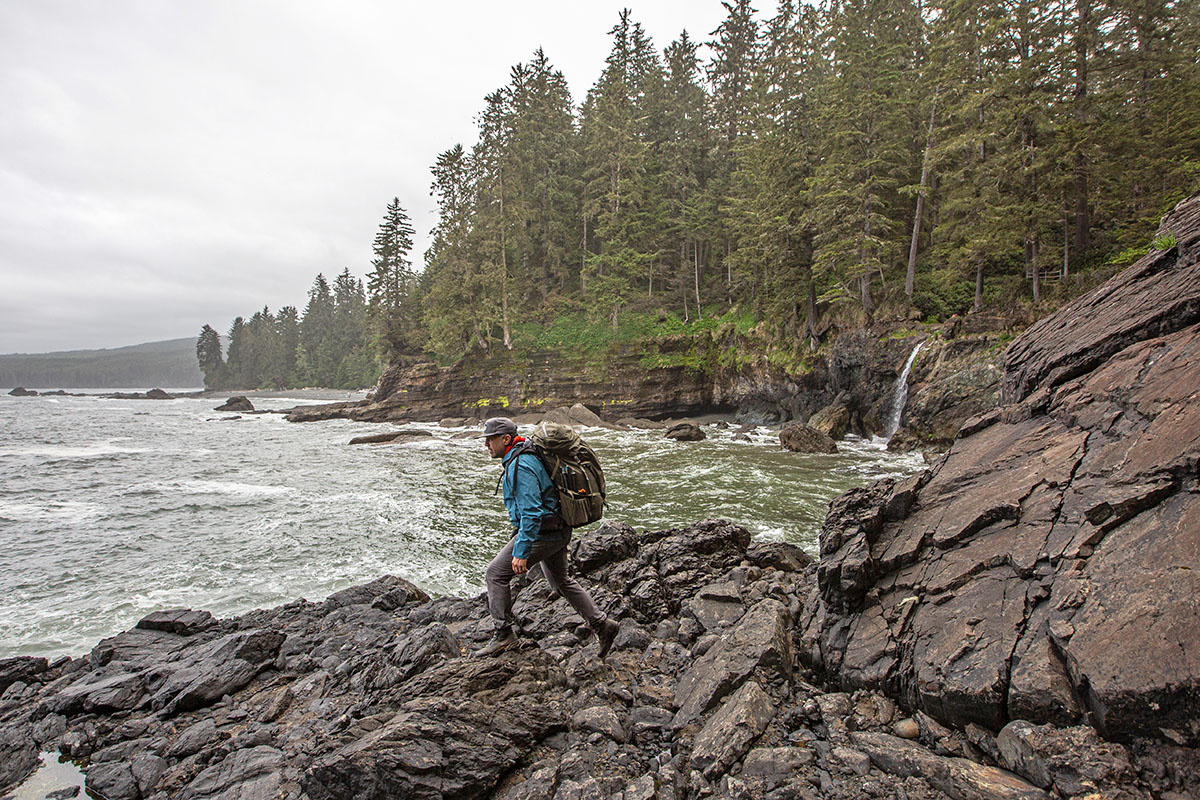
In my opinion, comfort is one of the Arc’teryx Ralle Jacket’s biggest strong suits. The C-Knit backer plays a big role: It’s noticeably soft and supple against the skin and lacks the stiff, crinkly feel of most traditional hardshell jackets. Arc’teryx also outfitted the shell with articulated patterning that allows for excellent all-around mobility. In practice, I haven’t experienced any restriction to movement while hoisting our canoe onto our vehicle, setting up camp, or loading gear in and out of our van. Combined with the accommodating fit (more in “Fit and Sizing” below), the Ralle has been reliably comfortable and unrestrictive throughout testing.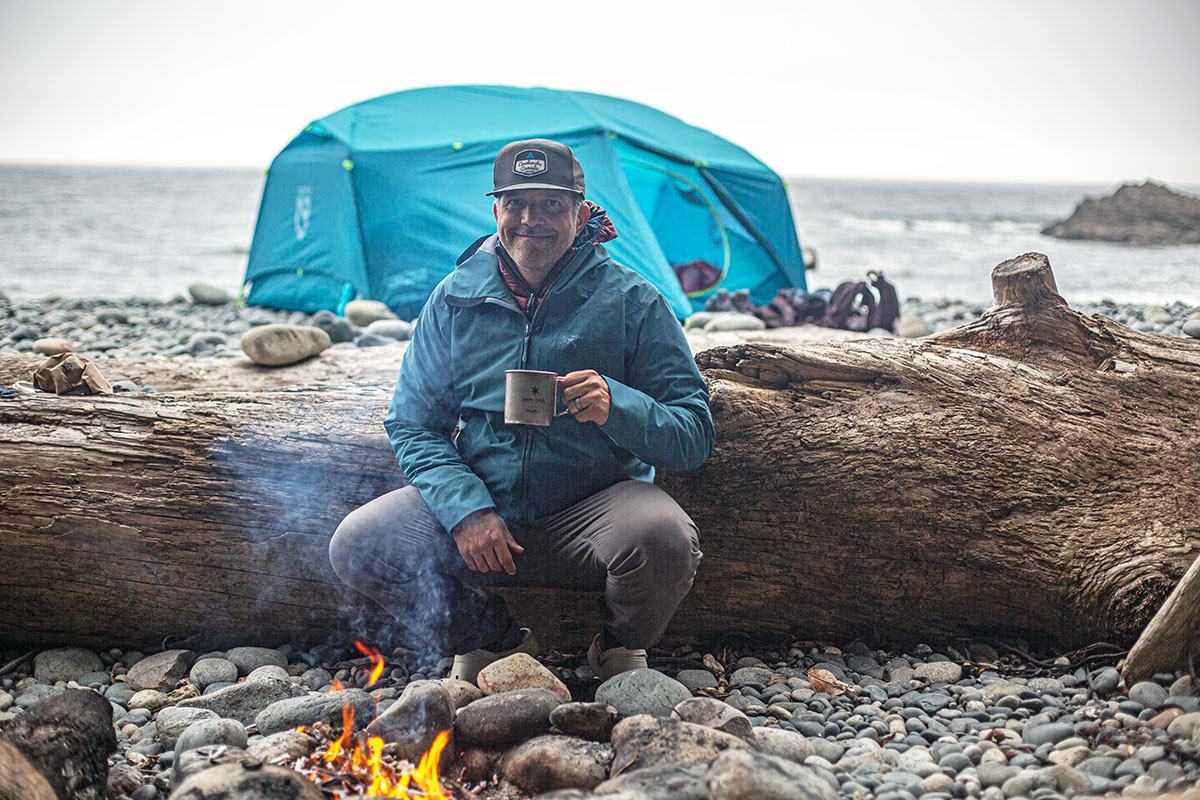
At 15.8 ounces for my men’s large (it’s listed at 15.2 oz.), the Arc’teryx Ralle Jacket isn’t particularly light—especially considering its fairly basic feature set—but is perfectly serviceable for casual and around-town use. For comparison, you can shave some weight with many of Arc’teryx’s more technical shells, including the Beta Jacket (10.6 oz.), Beta LT Jacket (13.9 oz.), or Alpha Jacket (13.1 oz.). Even my Patagonia Torrentshell 3L, which is similarly everyday-friendly but has a noticeably less streamlined feel, comes in less than the Ralle at 14.1 oz. That said, the Ralle is the thickest of the bunch by a large margin and a step up in all-out protection from the Torrentshell.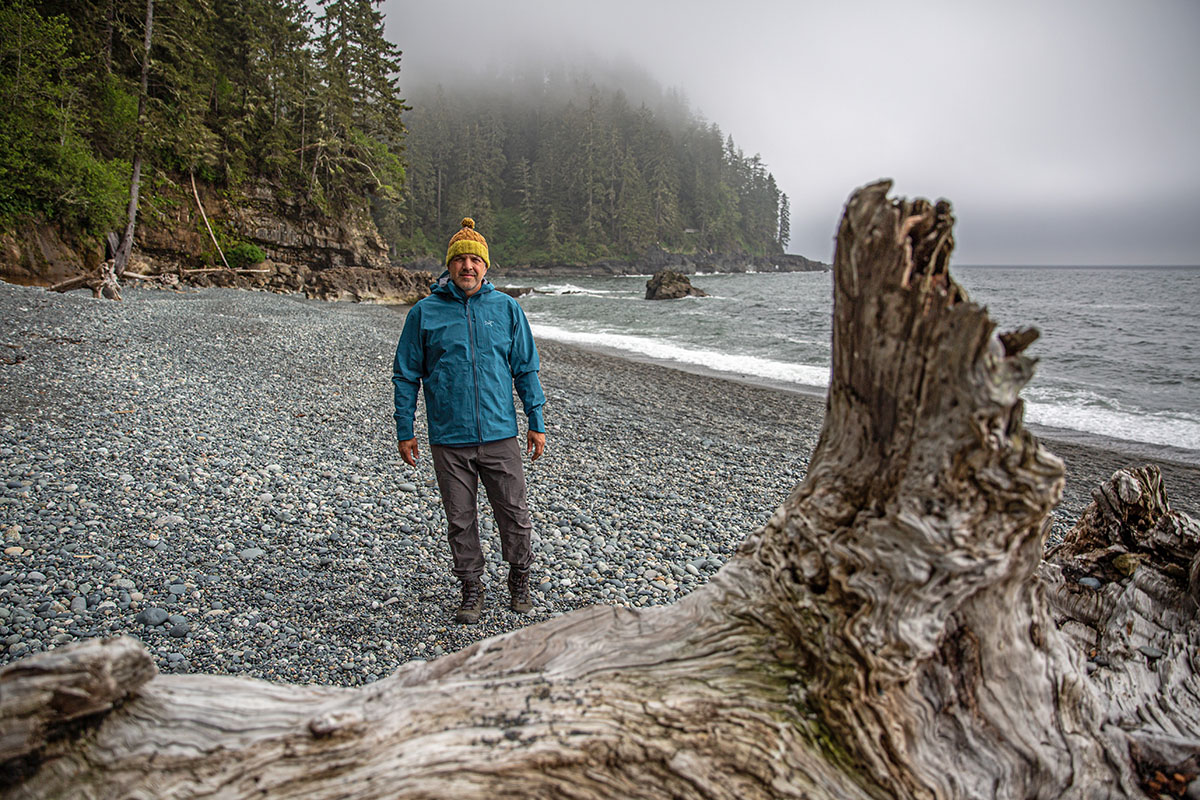
Despite its middling weight, the Arc'teryx Ralle Jacket does pack down nicely into its own hood. Once compressed, it’s about the size of a 32-ounce Nalgene bottle, which is perfectly reasonable for day hikes and other casual outdoor pursuits. When I’m in a hurry, I often just stuff it around other gear to fill out the nooks and crannies in my pack. Regardless of how you choose to stow it, the Ralle takes up surprisingly little space considering its burly and weather-ready build.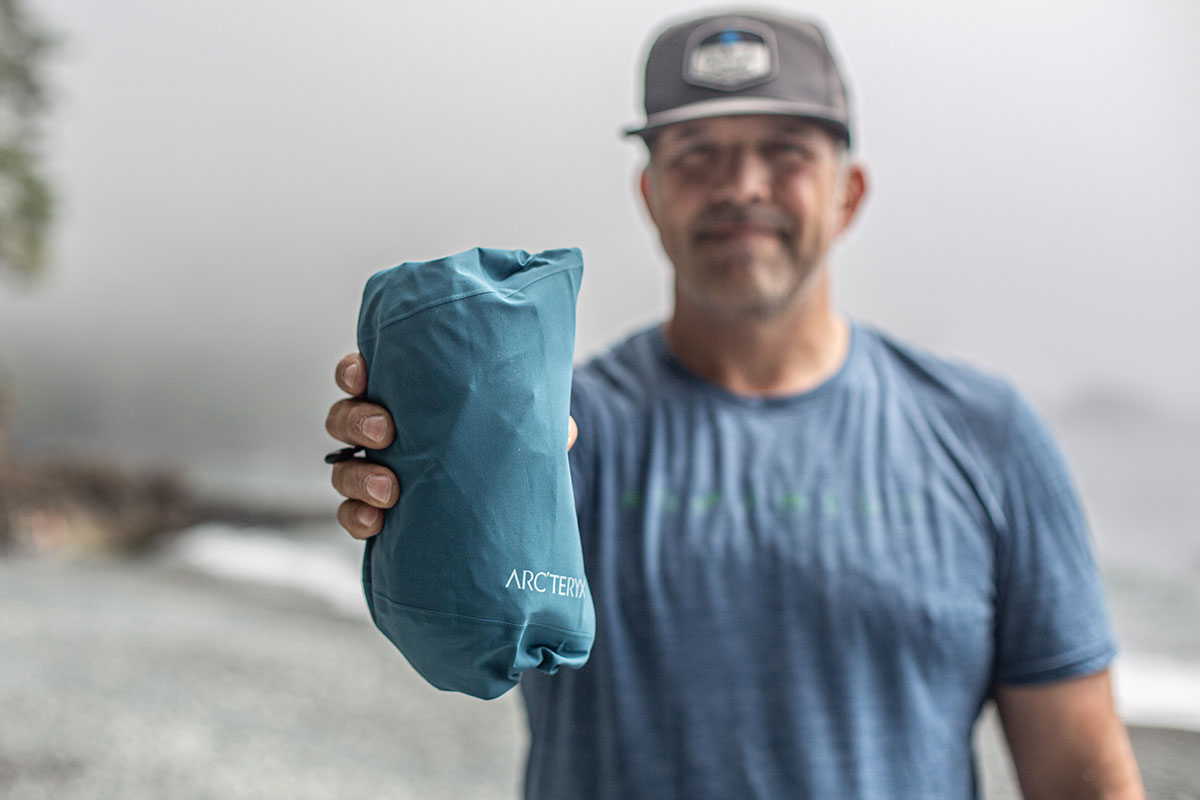
Arc’teryx has their hood designs dialed in, and the Ralle’s StormHood is another well-executed and practical iteration. It’s not helmet-compatible like what you get with the Beta LT or Alpha Jacket, but that’s not too surprising—or limiting—considering the Ralle’s more casual intentions. And the rest of the design is very thoughtfully done: The brim is large enough to prevent water from dripping onto my face, there’s a cozy patch of fleece along the inside of the collar, and the single drawcord at the rear cinches the hood evenly around the head. It’s also easy to operate with one hand, which isn’t always the case. 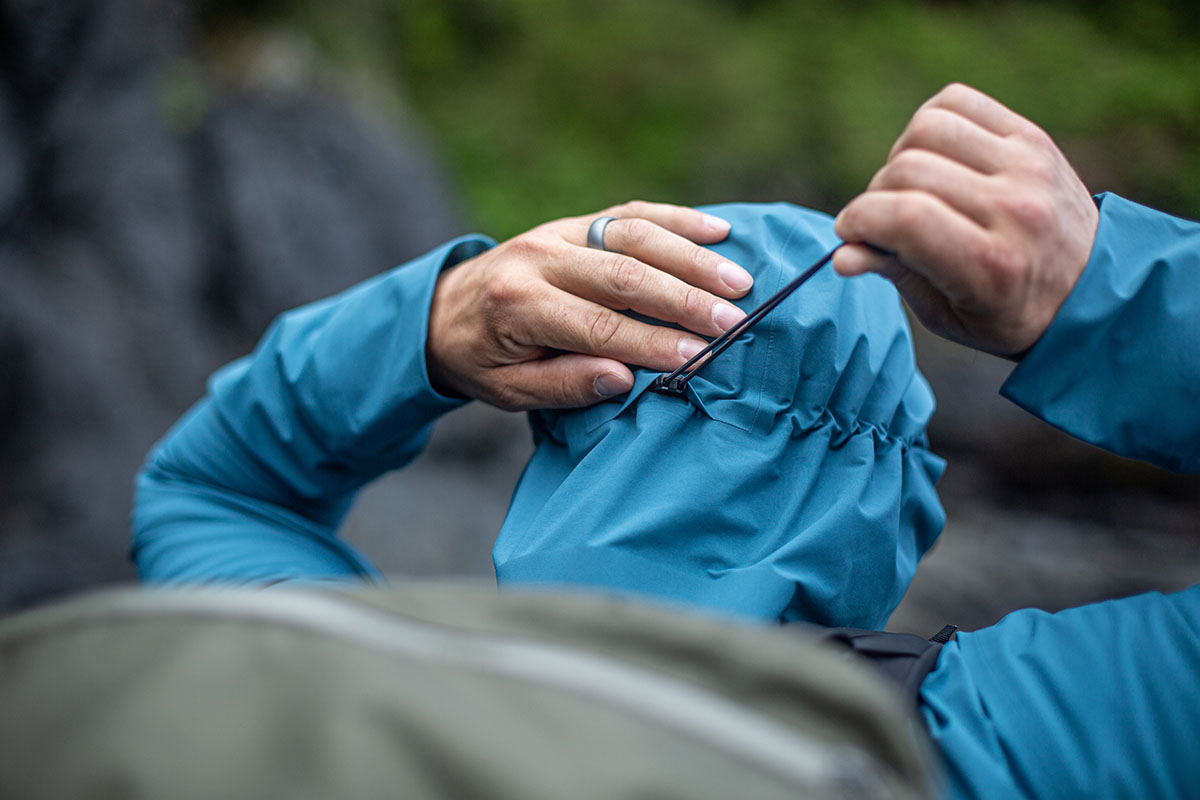
The Arc'teryx Ralle Jacket comes equipped with four zippered pockets, which is on the minimalist end among hardshells but sufficient for everyday use. The hand pockets are generously sized and great for storing items like my fly box, gloves, or Garmin inReach, while the exterior chest pocket provides quick and easy access to necessities like a phone or wallet. Rounding out the layout is a smaller pocket located at the bottom right of the interior—a nice spot for keys, memory cards, or other small valuables that I want to keep safe. Finally, as I mentioned above, all of the exterior pockets have protective flaps and zipper “garages” to guard against moisture making its way inside.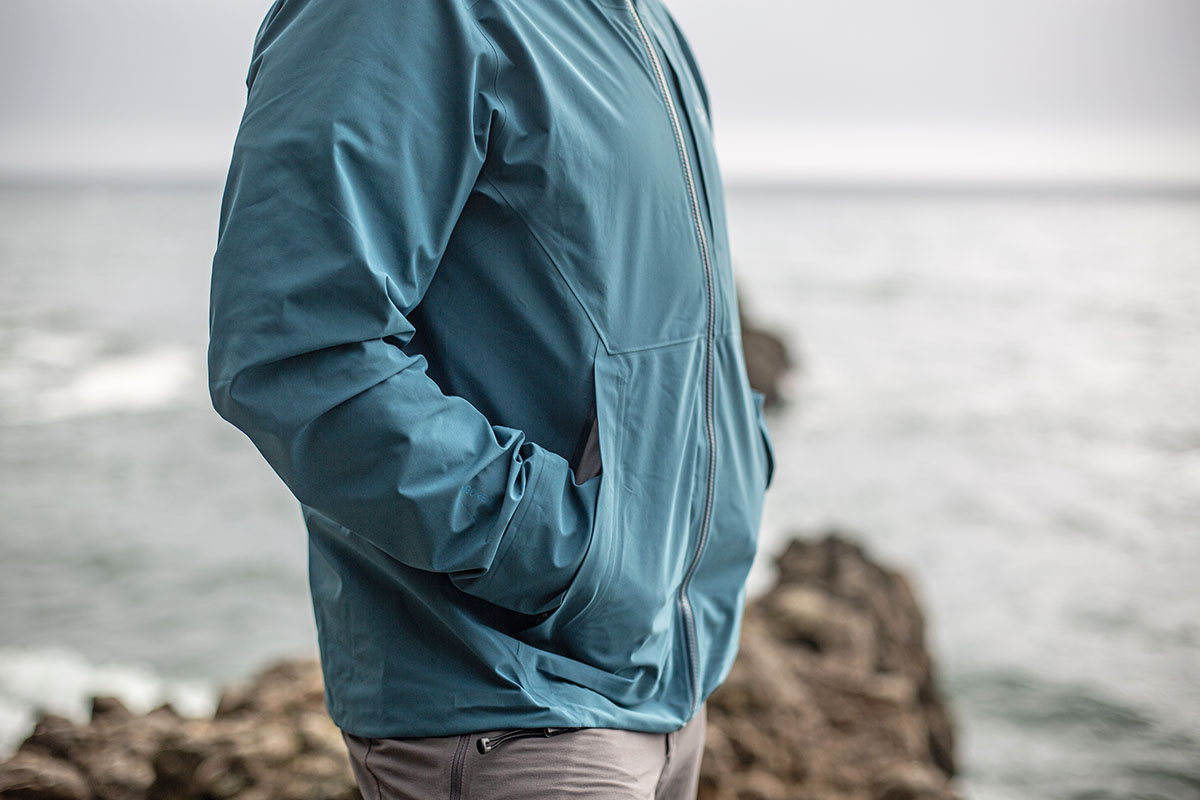
I have yet to experience any durability issues with an Arc’teryx shell, and the Ralle Jacket is yet another hardwearing and well-built piece. As I touched on above, the jacket has a very trustworthy feel thanks to its robust 80-denier (D) shell that’s highly resistant to tears and abrasion. In fact, it feels reminiscent of my favorite ski jacket, the Arc’teryx Sabre, which also features an 80D, 3-layer Gore-Tex build—very high praise given the Ralle’s more casual intentions.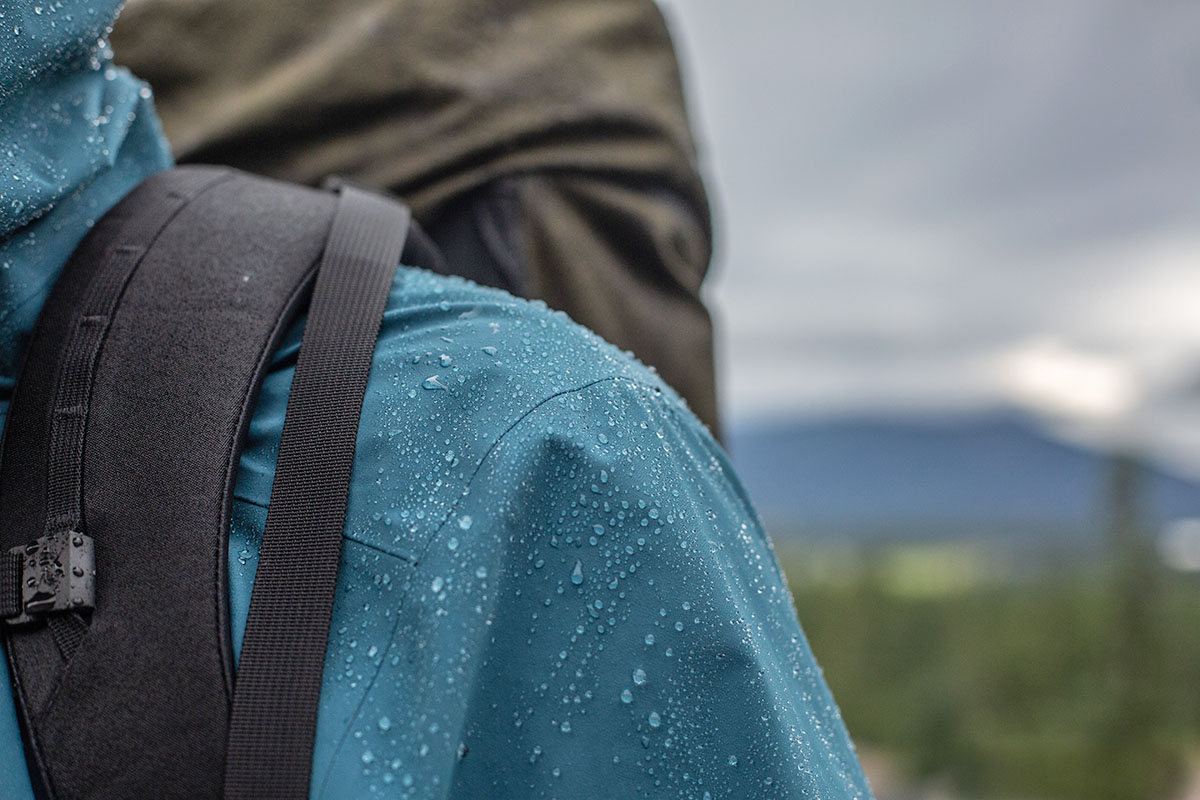
In practice, the Ralle Jacket has performed exactly as expected. Despite haphazard treatment—including being stuffed unceremoniously into my backpacking pack and dry bag, sitting at the bottom of our canoe, getting thrown in the back of our van, and even being used as a sit pad for picnic lunches—everything is holding up extremely well. All of the seams are intact, the zippers continue to operate smoothly, and there have been no signs of wetting out. Given my experiences thus far, I expect the shell to have a very long and healthy lifespan.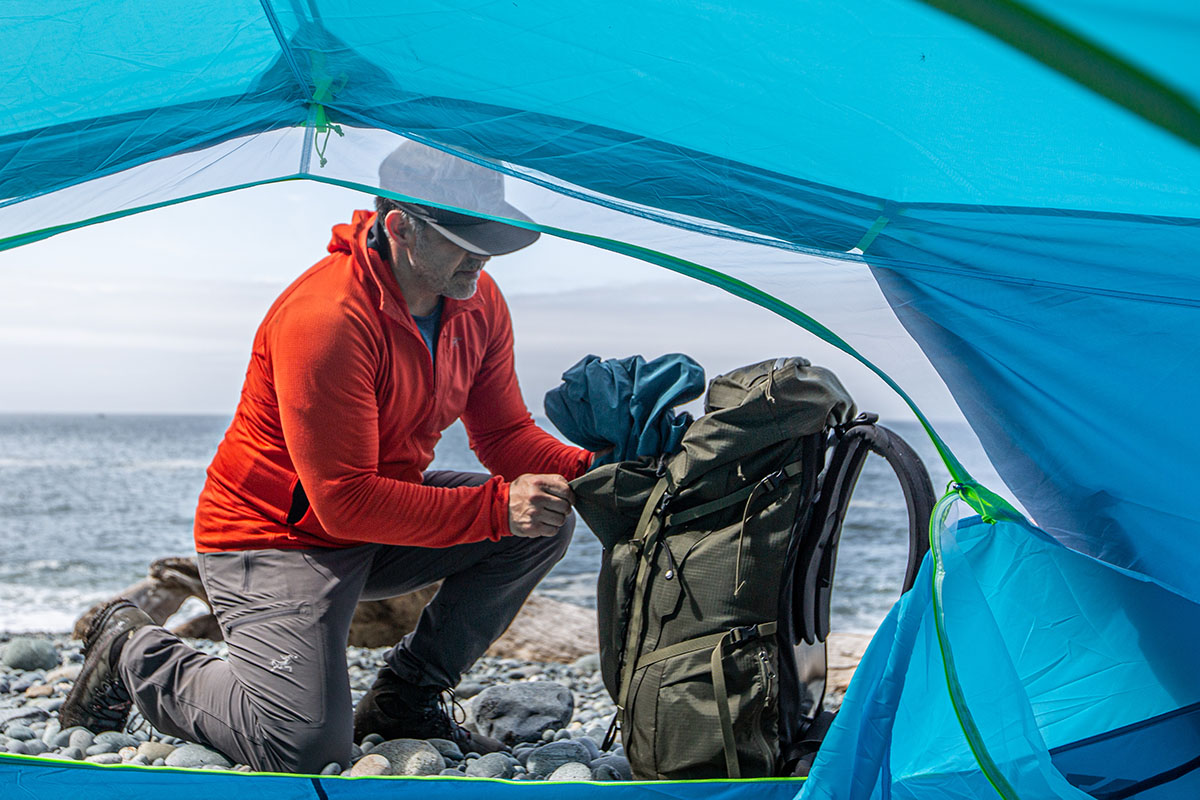
The Ralle Jacket boasts Arc’teryx’s “regular” fit, which is designed to allow room for layering underneath without feeling overly bulky. In my usual size large, I was able to comfortably pair the jacket with either my Patagonia Nano Puff Hoody and Arc’teryx Cerium down jacket. I did find the waist and arms to be a little narrow for my broader build, but this didn’t interfere with overall mobility. And I really like the cuffs, which extend a few inches beyond my hands to help maintain full coverage when raising my arms overhead but don’t feel overly long when standing still. I would prefer a little more length around back—the Ralle is relatively short at 29.1 inches for my size large, while the more technical Beta LT is 31.1 inches—but it’s long enough to stay put under a hipbelt.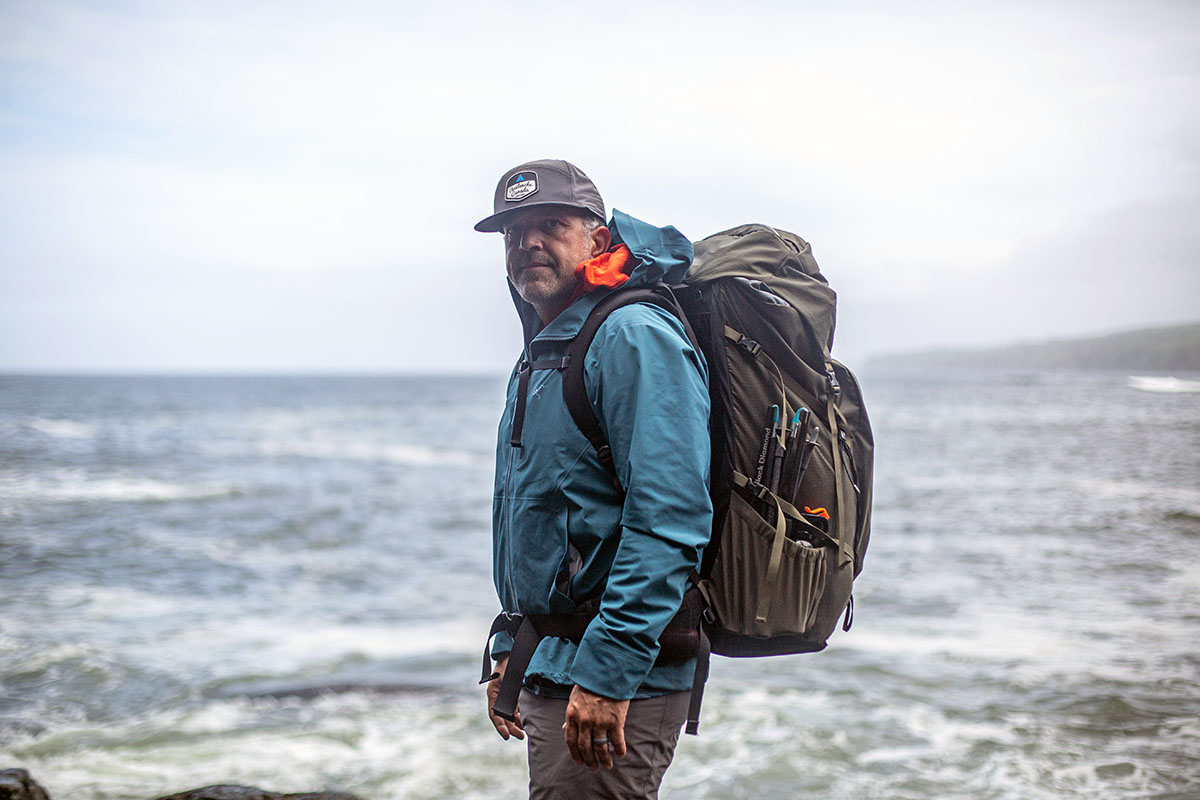
Arc’teryx has been upping their sustainability efforts of late, and the Ralle Jacket is a nice reflection of their ongoing progress. First, the jacket uses bluesign-approved materials that have been deemed safe for workers, consumers, and the environment. It also contains recycled nylon and features a dope-dyed shell that requires less water and energy during production than standard dyeing practices. Finally, Arc’teryx used a PFC-free DWR finish that forgoes the use of harmful perfluorocarbons. Taken together, it’s a solid all-around effort and a nice indication of where the industry is headed. 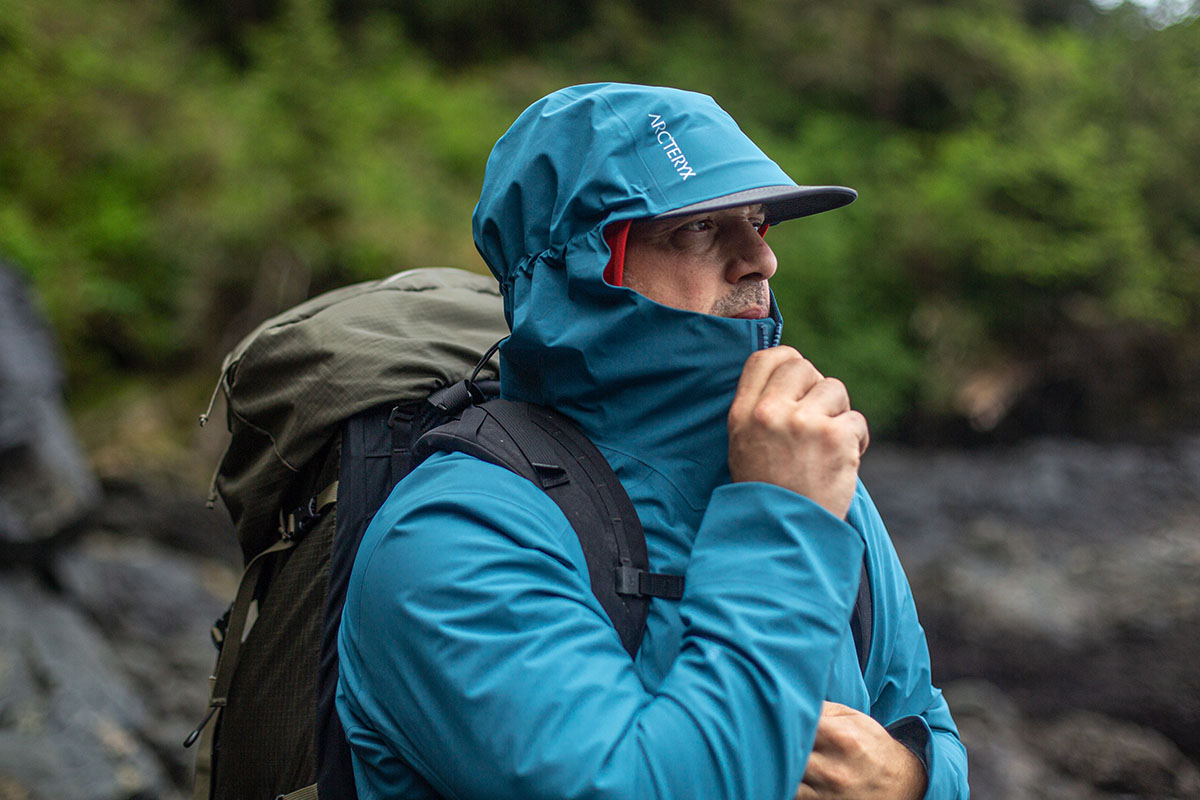
I tested the men’s Ralle Jacket for this review, and it’s also sold in a couple other styles. First is the Ralle Long Jacket, which costs $50 more, has a longer cut for additional coverage, and weighs a little more at 15.9 ounces but retains an otherwise identical feature set and overall build. Rounding out the collection is the Ralle Lightweight Jacket ($450), which features a similar Gore-Tex with C-Knit build but forgoes a chest pocket and uses a noticeably thinner shell fabric to keep weight to an absolute minimum (9.2 oz.). There are no women’s versions currently available, but the Salal collection—which includes both a long coat and anorak—has similar appeal with around town-friendly styling and a 3-layer Gore-Tex with C-Knit construction (although both are much thinner at 40D).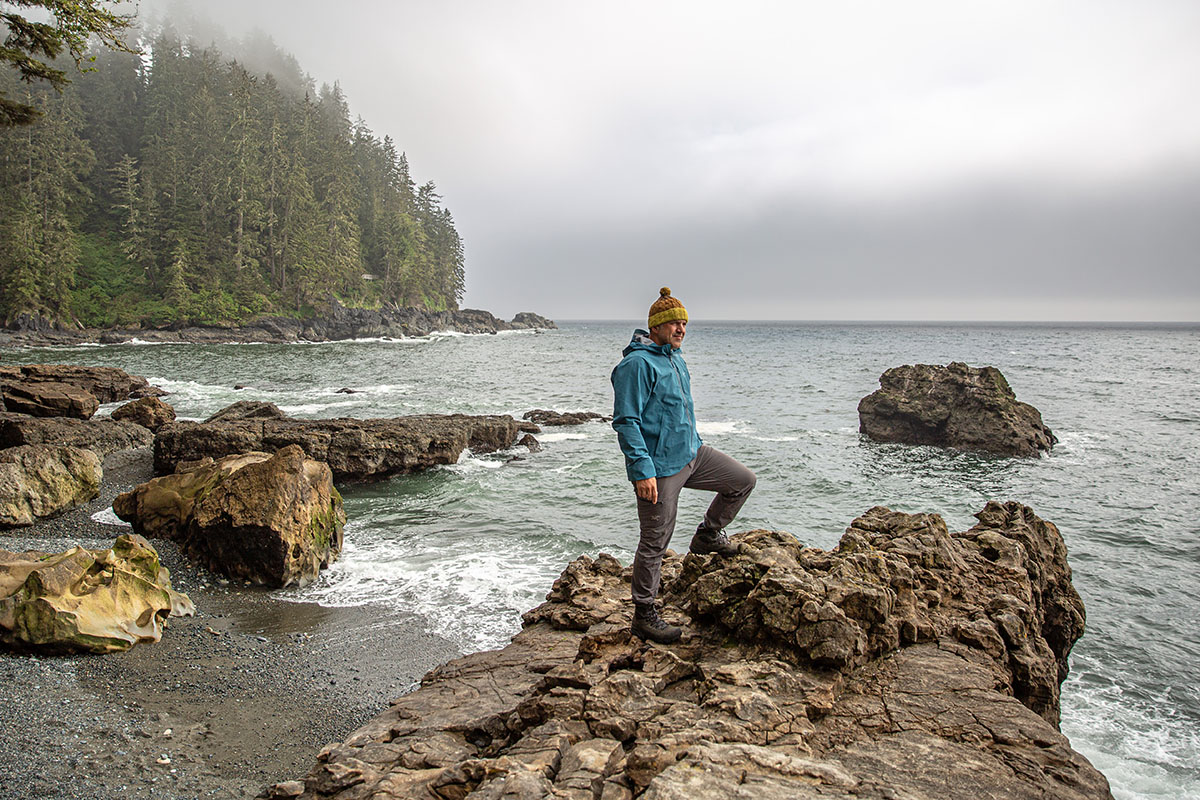
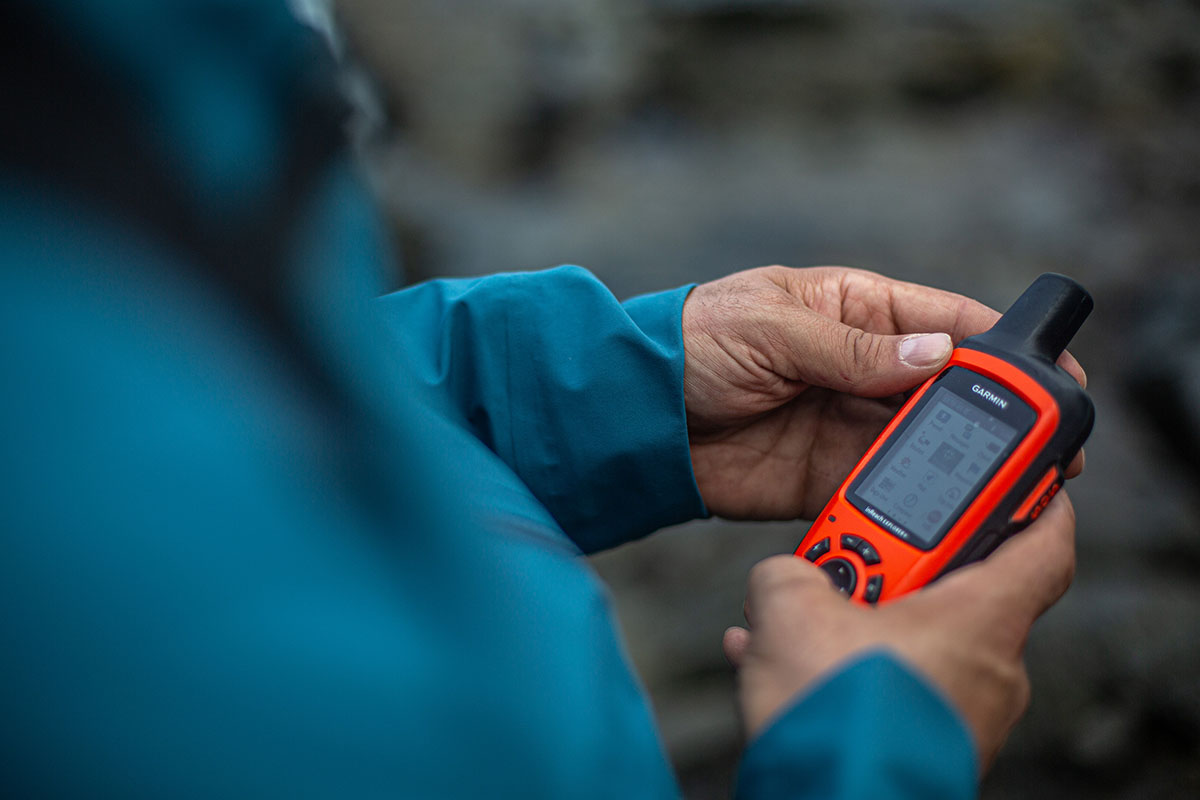
| Jacket | Price | Weight | Waterproofing | Denier | Pit Zips | Pockets |
|---|---|---|---|---|---|---|
| Arc'teryx Ralle Jacket | $500 | 15.2 oz. | 3L Gore-Tex | 80D | No | 2 hand, 1 chest, 1 internal |
| Arc'teryx Beta LT | $450 | 13.9 oz. | 3L Gore-Tex | 40D | Yes | 2 hand |
| Arc'teryx Beta Jacket | $400 | 10.6 oz. | 3L Gore-Tex | 30D | No | 2 hand, 1 internal |
| Patagonia Torrentshell | $179 | 14.1 oz. | 3L H2No | 50D | Yes | 2 hand |
| Fjallraven Keb Eco-Shell | $500 | 1 lb. 2.3 oz. | 3L Eco-Shell | 60D | No (vents) | 2 chest, 1 sleeve, 1 internal |
The Ralle is an impressively well-built everyday hardshell jacket, but it’s on the heavier and more basic end for technical use. If you plan to use your shell mostly for hiking, backpacking, or climbing, we’d instead point you to Arc’teryx’s own Beta LT Jacket. For $50 and 1.3 ounces less than the Ralle, the Beta LT boasts a longer cut (by around 2 in.), tacks on pit zips for easy venting, and has a helmet-compatible hood. Like the Ralle, the Beta LT also uses a proven 3-layer Gore-Tex build with a tricot backer for added next-to-skin comfort, although it’s much thinner at 40D compared to the Ralle’s 80D construction. The Beta LT is also lighter on storage with just two hand pockets, and the “fitted” fit is much trimmer for performance use. There’s no question that it’s the better match for backcountry pursuits, but the Ralle’s thicker build and everyday-friendly feature set and styling win out for daily wear.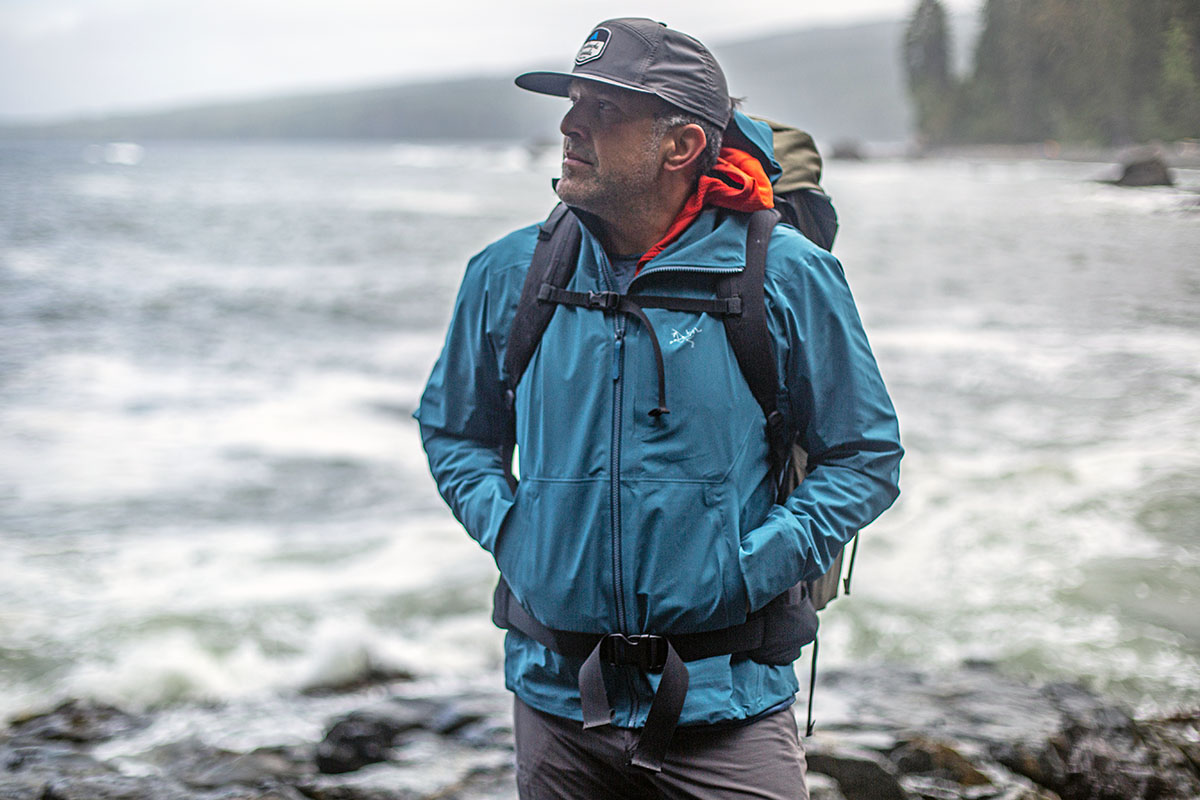
Next up is Arc’teryx’s standard Beta Jacket, which is a nice middle ground between the more technical Beta LT and casual Ralle Jacket. For a considerable $100 less than the Ralle, the Beta Jacket offers a similar mix of protection and comfort with the same 3-layer Gore-Tex with C-Knit construction. It also gets the clear edge in weight at 10.6 ounces and compresses down much smaller for stuffing in a pack on backcountry adventures, although there are some tradeoffs to note. First is durability: The Beta’s 30D face fabric is on the thinner end and less confidence-inspiring than the Ralle’s 80D build. Second is features: The Beta boasts three pockets compared to the Ralle’s four, uses a more streamlined hood design (that’s also not helmet-compatible), and has a trimmer fit that’s not as layering-friendly as the Ralle’s regular cut (for more, see our in-depth Beta review). In the end, the Ralle wins out for strictly around-town use with its thicker build and more urban-friendly styling, but the Beta is a great quiver-of-one shell for mixed outdoor and everyday wear.
Moving back toward the more casual end of the spectrum, Patagonia’s Torrentshell 3L Jacket has been our favorite rain jacket for multiple seasons thanks to its reliable protection and impressive versatility at a great price. As its name suggests, the Torrentshell has a hardshell-like 3-layer construction that’s very weather-worthy, and the interior’s soft-touch tricot lining adds a nice dose of comfort (similar to the Ralle’s C-Knit backer). You also get a thoughtfully executed feature set that includes pit zips for dumping excess heat and a two-way adjustable hood—all for around an ounce lighter and a whopping $321 less than the Ralle. However, the Patagonia is limited on storage with just two hand pockets, has a thinner 50D face fabric, and is noticeably stiffer and noisier than the Ralle. In the end, we think the vast majority of folks will find the Torrentshell to be a near-perfect match for everyday and light backcountry use, but the Ralle is a noticeable step up in overall quality and craftsmanship for those willing to spend up.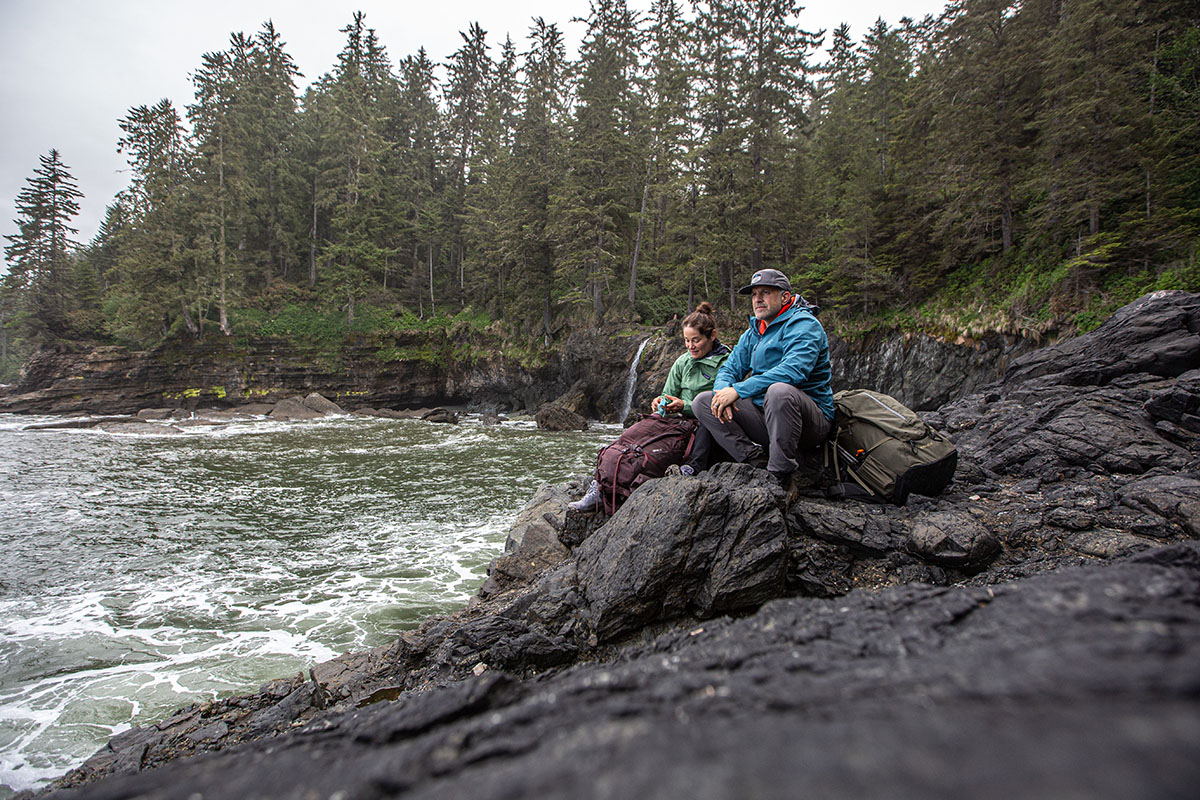
Fjallraven is known for their deft balance of performance and style, and their Keb Eco-Shell Jacket sticks to that formula. Instead of Gore-Tex, Fjallraven opted for their Eco-Shell membrane that provided solid protection throughout testing. The feature set lines up well, too, including water-resistant zippers, Velcro cuffs, a helmet-compatible hood, and side vents that open wide when heat starts to build. Final highlights include a soft and stretchy face fabric and nice assortment of classy colorways. That said, the Keb uses a thinner shell (60D), features dual chest pockets rather than hand pockets, and checks in heavier than the Ralle at 1 pound 2.3 ounces, which limits its appeal for weight-conscious pursuits like backpacking or backcountry skiing. If you’re looking for a joint everyday and outdoor shell, we’d opt for the lighter and more durable Ralle. For frontcountry missions and the odd day at the resort, however, the Keb offers an enticing mix of style and performance for the same price as the Arc’teryx.
Editor’s note: We usually provide a live price comparison table below our outdoor gear reviews, but the Ralle is currently only available directly through Arc'teryx. You can see the Ralle Jacket page here and support us in the process. Thanks!